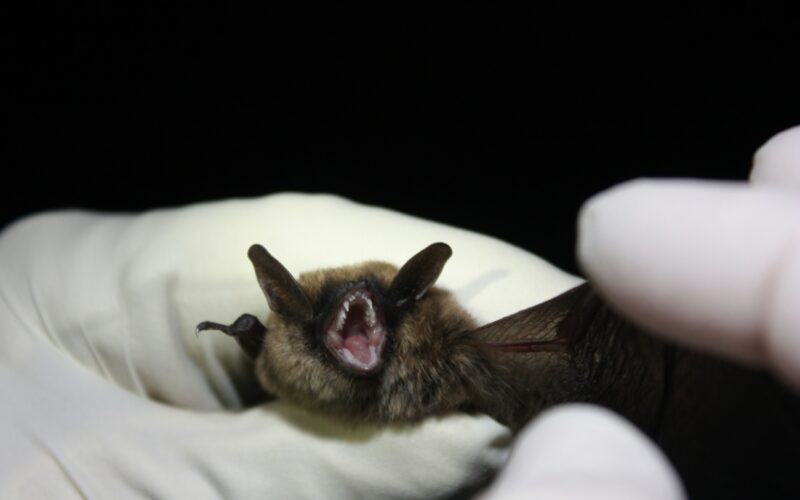Photo Courtesy of the U.S. Fish and Wildlife Service
AUM’s biology professor Matthew Grilliot shares his experiences researching these bats
By: Kate Lindsey-Hunter
Not only do the peaceful cliffs of northern Alabama hide breathtaking scenery, but they also protect one of the rarest animals on the planet. An elusive species of bat lives up among the rocks, unnoticeable but vital to the environment it inhabits, according to one of Auburn University at Montgomery’s professors.
AUM’s experienced biology professor and environmental opportunist Matthew Grilliot has spent a significant portion of his career researching these bats. Although his work has been conducted across continents, it has gained new significance in the Southern Appalachians. Grilliot elaborated on how his passion for learning about the Eastern Small-footed Myotis has inspired him to pursue a particular goal.
“I like to ask questions about things I see in nature,” said Grilliot, who is an associate professor in the Department of Biology. He explained that the species is so rare that it baffles even the most accomplished scientists. Like many other bat species, the Eastern Small-footed Myotis are experiencing rising challenges from habitat loss and environmental stressors, which makes understanding and protecting them an urgent concern.

Grilliot studied the broader environmental sciences early in his academic career. Although, he eventually developed an interest in animals and wildlife. His initial focus was on other small animals, but he became interested in bats because of opportunities to work with students and colleagues. These fascinating creatures, frequently misunderstood and forgotten about, brought unexpected challenges and ideas.
Grilliot’s previous studies on the vocalizations of big brown bats demonstrate the advanced nature of bat communication. Grilliot’s 2015 study showed that males prefer echolocation calls from females who are more likely to mate. This study revealed that big brown bats have a keen sense of social awareness.
His 2014 study discovered shifts in echolocation across seasons. This confirmed that bats modify their cries to correspond with their mating patterns. Grilliot’s findings highlight the importance of bat vocalizations not only as navigational devices but also for social interactions and procreation.
Grilliot clarified, “Bats are keystone species that play an essential role in controlling insect populations.” Courtney Celley’s 2021 report from The U.S. Fish and Wildlife Service states that because bats eliminate insects that damage crops and lessen the need for pesticides, agriculture benefits yearly by billions of dollars. In states where agriculture is the main driver of the economy, like Alabama, this function is extremely important.
Since they are difficult to come by, some bat species, like the Eastern Small-footed Myotis, remain unknown. This can make research of these bats challenging despite their significance. According to Grilliot, “They live in rocky habitats and crevices that are difficult to access… Standard bat surveys frequently overlook them completely.”
The work that the bat-focused professor is currently doing in the Southern Appalachians is a revolutionary shift in how scientists study these bats. The Eastern Small-footed Myotis typically lives in tiny rock crevices and cliff sides. Although, these locations have been overlooked in previous surveys that have concentrated on broad spaces and caves. To close this gap, Grilliot’s team has created a hybrid strategy that combines overnight mist-netting near rocky outcrops with visual searches conducted during the day. The range and behavior of the species in northern Alabama have been successfully identified thanks to this strategy.
Over the past two years, Grilliot and his students have helped to redefine the species’ southern range limits by confirming its presence in previously unreported places. The findings are encouraging since they show that the population is larger than previously thought. Grilliot stated, “Our knowledge of how these bats use their environment is still developing.” This new data will be essential for future conservation efforts.
According to Javier Folgar’s 2022 article at Bat Conservation International, effective conservation measures for bats require a thorough understanding of their habitat conditions and roosting behaviors. They stress that if species-specific needs aren’t taken into consideration, poorly educated conservation initiatives can frequently cause more harm than good. This is where Grilliot’s research is useful since it offers information that will influence how the species will be managed in the future.
Grilliot has his eye on a variety of species besides bats. He is also conducting a different investigation on the passerine birds to find out how climate change is affecting their diets. His studies are mostly concerned with calculating the calories in different food sources and monitoring changes in the structure of diets over time. “The goal is to link changes in diet to more significant environmental shifts, such as differences in temperature or severe weather,” he clarified.
As seen in studies from The Audubon Society, more than 60% of bird species in North America are threatened by climate change. In response, many of these species have already altered their migratory patterns and dietary habits. The goal of Grilliot’s research is to paint a clearer picture of how these dietary changes appear, revealing new information for conservation.
Grilliot stressed, “This isn’t just about the birds themselves, knowing how entire ecosystems are reacting to these changes is (also) important.”
Although the research has produced fascinating findings, there have been difficulties. “There’s always a funding hurdle,” Grilliot stated. “This kind of research is costly and time-consuming.” He is still dedicated to including students in his efforts despite these limitations. Every stage of the process, from performing field surveys to co-authoring research publications, has involved undergraduate and graduate students.
He went on to say, “Students bring new perspectives and fresh energy to the work.” Involvement from his students has improved their academic experiences and added important data to the research. Grilliot aims to keep up this collaborative approach, which has been essential to the project’s success.
Including students in research is essential, especially when dealing with subjects that are at the forefront of both public and scientific concerns. According to The National Park Service’s research on Southern Appalachian ecosystems, several environmental stressors, such as climate change and human activities, are putting the region’s specific ecosystem at risk. With this link to a wider, more complex environmental picture, student participation in initiatives like Grilliot’s is crucial to training the next wave of environmental scientists.
The future of species like the Eastern Small-footed Myotis is in jeopardy as the world struggles with the consequences of climate change and habitat destruction. A flash of optimism that these bats can be preserved through focused conservation efforts comes from Grilliot’s research. However, there’s still a lot to discover, he says.
Dr. Grilliot is bringing the unseen to light, one bat at a time, in the quiet of the Eastern Small-footed Myotis’s silent roost on the cliffs of northern Alabama.
“We discover something new each time we venture out,” Grilliot said with excitement. He hopes that by bringing attention to these often-overlooked species, his study will encourage a new generation of scientists to keep searching for answers.




